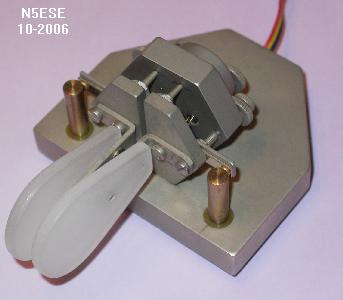
In 2006, I was invited to make a presentation for the NorCal QRP Club at Pacificon, the big hamfest out on the left coast. I had never been, but I was looking forward to the experience. Saturday night, NorCal had an auction, with Doug Hendricks as auctioneer (he's good). I walked away quite happy with a paddle which had been custom made by OK1DXD, and purchased in 2002 or 2003 by Chuck Adams, from whom I acquired it. I've given it a pretty good workout, and it compares nicely in feel and settability to my Begali Simplex. Here's a picture of the OK1DXD Paddle:

Also while at Pacificon, I participated in their tailgate swapfest Sunday morning. Very unlike similar events in Texas, and there were actually some bargains to be had. I found this very beautimous multi-section variable capacitor, with a very smooth action, and 5 equal sections 15-420 pF. For years, I've thought about building a TRF receiver similar to my old novice RU-19, and now I have the main component. Cost? $15.
The Temple Amateur Radio Club's 2004 swapfest on May 22 in Belton, Texas was a month late, but well worth the wait. I think there were double the number of hams and equipment, too, than I have ever seen there before. For some reason, a paddle bug (pun intended) bit me, and I bought three of them:
First, for $10 (because the guy wasn't sure if it worked, and because I bought some connectors from him), the following classic from the late 60s or early 70s: A Waters Model 361 CODAX integrated keyer and paddle:
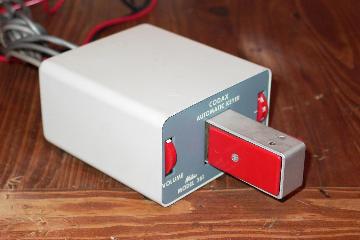
The paddle will never win any awards amoing CW ops for feel or speed, but is quite adequate for 13-15 wpm. As you can see from the picture below (with the fingerpiece removed, the paddle is constructed from hardened copper leaf, and relies on the "spring" of that for its return tension, plus a couple of set screws for spacing. This one required about half-an-hour of work to get it operational. Two battery contacts were corroded (it uses 6 AA batteries), and the paddle contacts needed to be burnished.
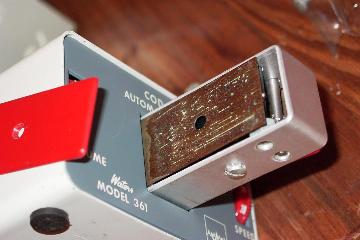
Like many of the early iambic keyers, it had self-completing dits and DAHs, but only DAH insertion. It's a tad tricky to use for someone (like myself) who is used to both dit and DAH insertion. Here's another closeup view of the paddle:
The next acquisition was a Cleng Electronics (Dallas, TX) Keyer and paddle set, known as the "Bugg" which I managed to talk down to $25.
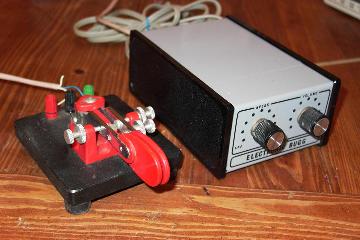
This one worked right out of the box, and both the paddle and electronics were in good shape. Like the previous keyer of the same vintage, this one is iambic, but with DAH insertion only. And this one is powered from line voltage. These paddles were quite usable, and I really liked the feel, though they probably aren't precise enough to support high speed (> 30 wpm) QRQ ops. Here's another picture of the paddle, with the fingerpieces reversed to give wider spacing:
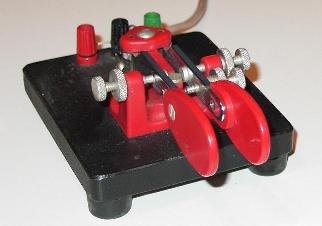
I'm ashamed to say I couldn't resist this next gorgeous mini-paddle by Mark Johnston AC7AZ, which I acquired for $50. It has gold-plated base, and chrome-plated uppers. It uses magnets instead of springs. The magnets seemed a tad weak to my taste, when maximally engaged. It has good weight, and a really nice feel for a mini-padlle. Here are two views:
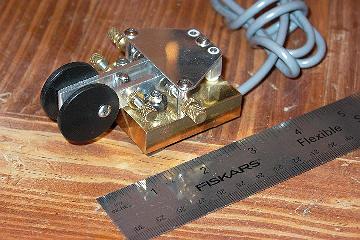
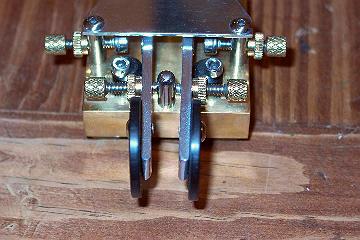
Lastly, we picked up this 100 Watt dummy load for $15. Typically, I see these priced at $35-45, at swapfests. After cleaning up the internal connector contacts, it was found to work perfectly. Data sheet says it's good DC-1 GHz, so I should be covered ;-)

73,
Monty N5ESE
dit dididit dit